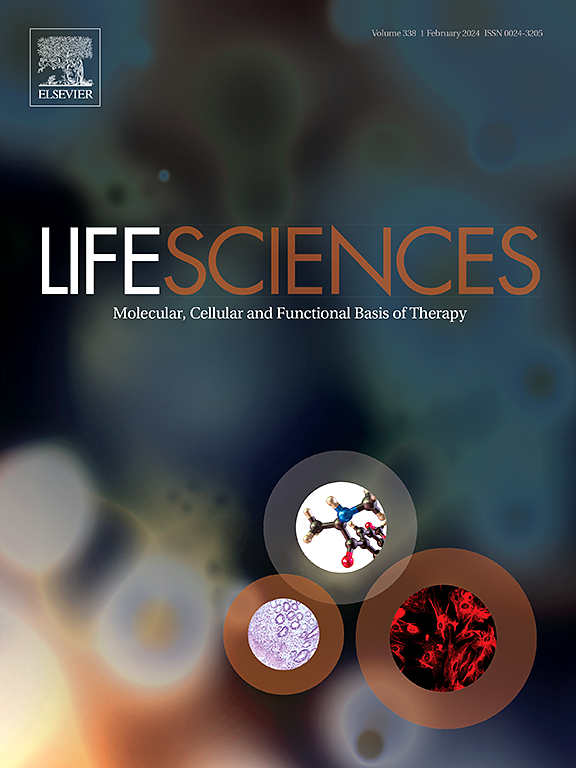高血糖对人体表皮角质细胞 UVB 反应的影响:洞察糖尿病皮肤对光致癌的抵抗力
IF 5.2
2区 医学
Q1 MEDICINE, RESEARCH & EXPERIMENTAL
引用次数: 0
摘要
紫外线(UV)B 诱导的人体表皮角质细胞(HEKs)损伤会引发光致癌性。然而,人们对糖尿病如何影响光癌发生还不甚了解。为了研究高血糖环境对 UVB 反应的影响,我们在正常葡萄糖(NG)或高血糖(HG)条件(G6 和 G26)下培养 HEKs,然后用 25 mJ/cm2 的 UVB 照射(G6UVB 和 G26UVB)。我们进行了新一代测序,并对 HEKs 的表达谱进行了生物信息学分析,以确定候选基因和所涉及的细胞反应。我们发现 UVB 在 NG 组和 HG 组培养的 HEK 中诱导了一致的反应,但它也特别在 HG 组中触发了某些不同的过程和通路。HG组中的459个差异表达(DE)基因揭示了它们在染色质重塑、核小体组装和干扰素信号激活中的作用。此外,在 G26UVB/G6UVB 比较中发现的 29 个 DE 基因(包括有效的肿瘤抑制基因 TFPI2)被认为是导致 HEKs 在 HG 环境中对 UVB 反应改变的关键基因。在 HG 培养的 HEKs 中,UVB 照射诱导的 TFPI2 表达明显高于 NG 培养的 HEKs。最后,HG 培养明显增加了氧化应激、环丁烷嘧啶二聚体的形成和细胞凋亡,同时降低了 HEK 在 UVB 照射后的存活率。在 HG 条件下发生的这些变化可能会介导细胞走向死亡和肿瘤消退。总之,我们的研究结果为 HG 条件如何降低角质形成细胞在紫外线照射后的光致癌性提供了证据和相关的分子基础。本文章由计算机程序翻译,如有差异,请以英文原文为准。
High-glucose impact on UVB responses in human epidermal keratinocytes: Insights on diabetic skin's resistance to photocarcinogenesis
Ultraviolet (UV) B-induced damage in human epidermal keratinocytes (HEKs) initiates photocarcinogenesis. However, how diabetes influences photocarcinogenesis is not well understood. To investigate the impact of high-glucose environments on responses to UVB, we cultured HEKs in normal-glucose (NG) or high-glucose (HG) conditions (G6 and G26), followed by UVB irradiation at 25 mJ/cm2 (G6UVB and G26UVB). We performed next-generation sequencing and analyzed HEKs' expression profiles bioinformatically to identify candidate genes and cellular responses involved. We found UVB induced consistent responses in both NG- and HG-cultivated HEKs, but it also triggered certain distinct processes and pathways specifically in the HG groups. The 459 differentially expressed (DE) genes in the HG groups revealed their roles in chromatin remodeling, nucleosome assembly, and interferon signaling activation. Moreover, the 29 DE genes identified in G26UVB/G6UVB comparison, including the potent tumor suppressor gene TFPI2, were considered key genes contributing to HEKs' altered response to UVB in HG environments. UVB irradiation induced significantly higher TFPI2 expression in HG-cultivated HEKs than their NG-cultivated counterpart. Finally, HG-cultivation significantly increased oxidative stress, cyclobutane pyrimidine dimer formation, and apoptosis, while reducing HEKs' viability after UVB irradiation. These changes under HG conditions probably mediate cell fate toward death and tumor regression. Overall, our findings provide evidence and associated molecular basis on how HG conditions reduce keratinocytes' photocarcinogenic potential following UVB exposure.
求助全文
通过发布文献求助,成功后即可免费获取论文全文。
去求助
来源期刊

Life sciences
医学-药学
CiteScore
12.20
自引率
1.60%
发文量
841
审稿时长
6 months
期刊介绍:
Life Sciences is an international journal publishing articles that emphasize the molecular, cellular, and functional basis of therapy. The journal emphasizes the understanding of mechanism that is relevant to all aspects of human disease and translation to patients. All articles are rigorously reviewed.
The Journal favors publication of full-length papers where modern scientific technologies are used to explain molecular, cellular and physiological mechanisms. Articles that merely report observations are rarely accepted. Recommendations from the Declaration of Helsinki or NIH guidelines for care and use of laboratory animals must be adhered to. Articles should be written at a level accessible to readers who are non-specialists in the topic of the article themselves, but who are interested in the research. The Journal welcomes reviews on topics of wide interest to investigators in the life sciences. We particularly encourage submission of brief, focused reviews containing high-quality artwork and require the use of mechanistic summary diagrams.
 求助内容:
求助内容: 应助结果提醒方式:
应助结果提醒方式:


